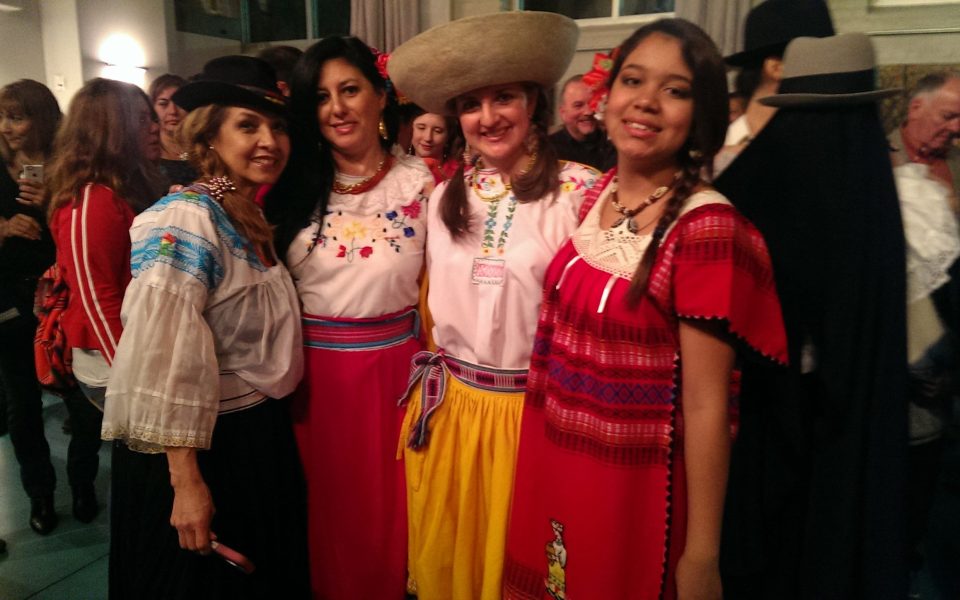by Sayaka Matsuoka
Rain fell in misty sheets, coating passersby with a cold, damp blanket on April 25 but it didn’t keep a stream of people from attending Casa Azul’s Noche Andina event. Tucked down a lonely alley off of South Elm Street in downtown Greensboro, the festivity lured in its attendees with the warmth of colorful notes played by guitars, flutes and drums.
The event was the third of its kind put on by the nonprofit, with previous years highlighting the art and culture of Argentina and later the Caribbean. This time Casa Azul set its sights on the Andean countries of Ecuador, Peru, Bolivia and parts of Colombia and Chile.
A four-piece band played lively music encouraging many attendees to sing along while clapping their hands or tapping their feet to the beat. Uniformly dressed in white-collared shirts and black pants, the band played an array of instruments consisting of two guitars — one full sized and one smaller known as a charango — wooden flutes and panpipes known as zampoñas and percussion instruments like the timbales or shallow drums and a cajón, which is a six-sided wooden box played by slapping the sides. The songs were filled with the kind of vivacity that caused one to smile, even if you couldn’t understand the Spanish lyrics.
But this just added to the authenticity of the event, given that the goal was to bring the culture of the Andean countries a little closer to Greensboro, not to cater to anyone else. Even the food was strictly traditional.
Those in attendance were mostly of Latino descent; many spoke Spanish. One woman from Chile expressed her gratitude for the event.
“I’ve been living in Greensboro for a couple years now but I just found out about this place,” she said. “We’re trying to connect with other Chileans here; I think it’s great!”
Claudia Femenias Gajardo, who serves on the organization’s board of directors, elaborated on the importance of the night.
“These events are a great way for people to connect with others in their culture,” she said. “We were surprised by the turnout. All of the Andean groups are here, with Colombia and Peru represented the strongest.”
Guests greeted each other while mothers sat in corners, bouncing babies on their laps, and vibrantly dressed dancers clad in patches of red, orange, and yellow walked to and fro.
Paintings depicting both rural and urban scenes from the focus countries lined the walls of the space. Some portrayed examples of nature like golden sunflowers and warm-toned trees while a few abstract pieces borrowed elements from Picasso and his affinity for African masks. Of the many paintings in the room however, the ones that seemed to be the most captivating were the portraits of Andean natives by Catalina Gomez.
Her work “Flutist-Flautista,” in the back corner of the room, highlighted the face of an older flute player with weathered lines of experience crossing his face. His focused expression looked out beyond the viewer as he played his wooden flute with gentle and wrinkled hands. Another work by Gomez hung on a wall across the room but shared the same humble and stark quality, this time in a young girl’s face. Titled “Little Mother,” the painting showed the girl with strands of hair in her face, carrying a baby on her back, both looking directly out at the viewer. Gomez, who is Colombian, lives in Atlanta now but used to live in Winston-Salem. All nine of the participating artists are connected to the area in some way, with a third of them currently living in the Triad.
As guests gazed upon the variety of paintings, a new art form took to the floor as the traditional-dress fashion show began.
“Join us on a journey through the Andes from the north to the south,” echoed the DJ’s voice.

Brightly clad women, men and children walked down the makeshift runway, exhibiting the traditional dress of the different Andean countries. The getups varied from dance attire to festival dress to everyday outfits. As the models strutted across the room, the DJ informed the audience of the background of the different styles, noting that many originated from African cultures, such as the tuntuna dress. Perhaps the most spirited dress, the black and orange outfit had a skirt that flared out well above the knees and shook with bells with every twist of the dancer’s hips. Later in the night, the model exhibited the full effect of the ensemble by dancing to the live music. She lit up the floor with her vibrant movements and her wide smile as onlookers clapped and cheered.
In the crowd, folks chatted as if they’d known each other for years and the synergy of the audience was warm and familiar, making Noche Andina not just a public event but something of a large family reunion.
Join the First Amendment Society, a membership that goes directly to funding TCB‘s newsroom.
We believe that reporting can save the world.
The TCB First Amendment Society recognizes the vital role of a free, unfettered press with a bundling of local experiences designed to build community, and unique engagements with our newsroom that will help you understand, and shape, local journalism’s critical role in uplifting the people in our cities.
All revenue goes directly into the newsroom as reporters’ salaries and freelance commissions.



Leave a Reply